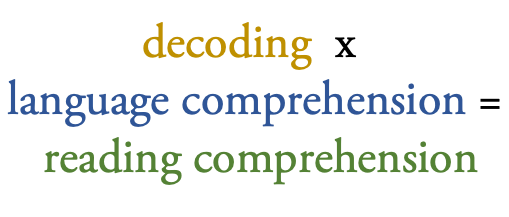Foundational Reading Instruction Procedure
Key Components
According to the Simple View of Reading, reading comprehension is the product of decoding and linguistic comprehension.
As teachers, we are responsible for supporting students with both parts of the reading comprehension equation. The following resources primarily target decoding in English and Swahili. This procedure has eight components: phonemic awareness, visual drill, auditory drill, blending drill, new concepts, word work, irregular words, and connected text. Taking an explicit, systematic, multisensory approach to teaching reading helps all students succeed, including children with disabilities.
Online and printable resources are embedded and linked below. Choose whichever is the best fit for your setting,

Phonemic Awareness
Phonemic awareness is being able to identify individual sounds in words. For example, “ship” has three sounds: /sh/ /i/ /p/. “Enda” has four sounds: /e/ /n/ /d/ /a/. When students can hear the individual sounds in words, they can match the sounds with letters to read and spell.
To use the resource embedded below, choose the number of sounds in the target word. For example, if the word is “choo,” select “2.” Ask students to say the sounds while you drag one circle to a box for each sound. For example, you would move one circle while students say /ch/ and another while they say /o/.
Students can follow along with their own Elkonin boxes or tap sounds on their fingers.
The following manipulatives are from Toy Theater. Visit their website for more.
Visual Drill
The purpose of the visual drill is for students to identify letters (or groups of letters) and their sounds. Show students a card and ask them to say the letter name(s) and sound (e.g., “b” says /b/).
You can project the embedded resource below and point to letters for students to identify. The cards specific to Swahili are coming soon.
You can also download printable cards for English and Swahili.
The following cards are from UFLI Foundations. Visit their website for more.
Auditory Drill
The purpose of the auditory drill is for students to practice connecting sounds with how they are spelled.
- The teacher says the target sound.
- Students echo the sound.
- Students say the letters as they write all the ways they know to spell the sound. For example, for the “long a” sound, students might write “ai” and “a_e.” Students can also write the spellings in the air with their fingers or trace them on their desks.
The following resource is from The Math Learning Center. Visit their website for more.
Blending Drill
The purpose of the blending drill is for students to practice combining sounds to make syllables and words.
The resource below can be used for English words that follow a consonant-vowel-consonant (CVC) pattern (e.g., “cat” and “dog”). It can also be used for syllables in Swahili (e.g., “ba” and “ku”).
First, click on the three horizontal black lines and select the letters you would like to include. These should be letters and letter patterns you have already taught. For English, you will select blue, yellow, and green buttons. For Swahili, you will select blue and yellow buttons.
Then, click the black check mark.
Last, click the buttons to create words/syllables for students to read aloud. They should say each sound separately and then blend the sounds together. For “dog,” they would say /d/ /o/ /g/, dog. For “ku,” they would say /k/ /u/, ku.
For a more detailed tutorial, click the black question mark.
The following resource is from UFLI Foundations. Visit their website for more.
New Concepts
Your curriculum designs will guide you on the order for introducing new concepts. Once you have taught a new skill in this section, you can add it to the visual, auditory, and blending drills above for subsequent days.
Word Work
The purpose of word work is for students to apply their letter and sound knowledge to create words.
Procedure: The teacher says a word aloud. Students tap out the sounds on their fingers and then move letter cards to make the word. The teacher says a new word that requires a change (e.g., turn “mat” into “pat”). Students tap out the sounds and change their letter cards to make the new word.
Ideally, students will have their own letter cards. The resource embedded below can be used to model the correct answer for students. It is applicable for both English and Swahili.
You can also download a printable word mat and letter tiles.
The following resource is from UFLI Foundations. Visit their website for more.
Irregular Words
In English, many common words have parts that are irregular, or non-decodable. Fortunately, most words have some regular parts. Learn more about the heart words procedure to teach these words efficiently and effectively. This procedure is not necessary when teaching Swahili, as it has no irregular words.
Use the slides below, or download printable cards here. You can also open the slides in a new window to see explanations of sounds and how to adapt the procedure for different dialects and accents.
The following resource is from UFLI Foundations. Visit their website for more.
Connected Text
The purpose of the previous steps is to prepare students to read longer passages and books. “Connected texts” let students apply their new reading skills.
Ideally, students will read texts that include the target sounds and spelling patterns for that lesson. However, if you do not have texts that meet those requirements, you can use books that are at the students’ reading levels. Below, you can use African Storybook to access free storybooks in English, Swahili, and other languages. You can find more books on the BookSmart and eKitabu apps.
The following resource is from African Storybook. Visit their website for more.
